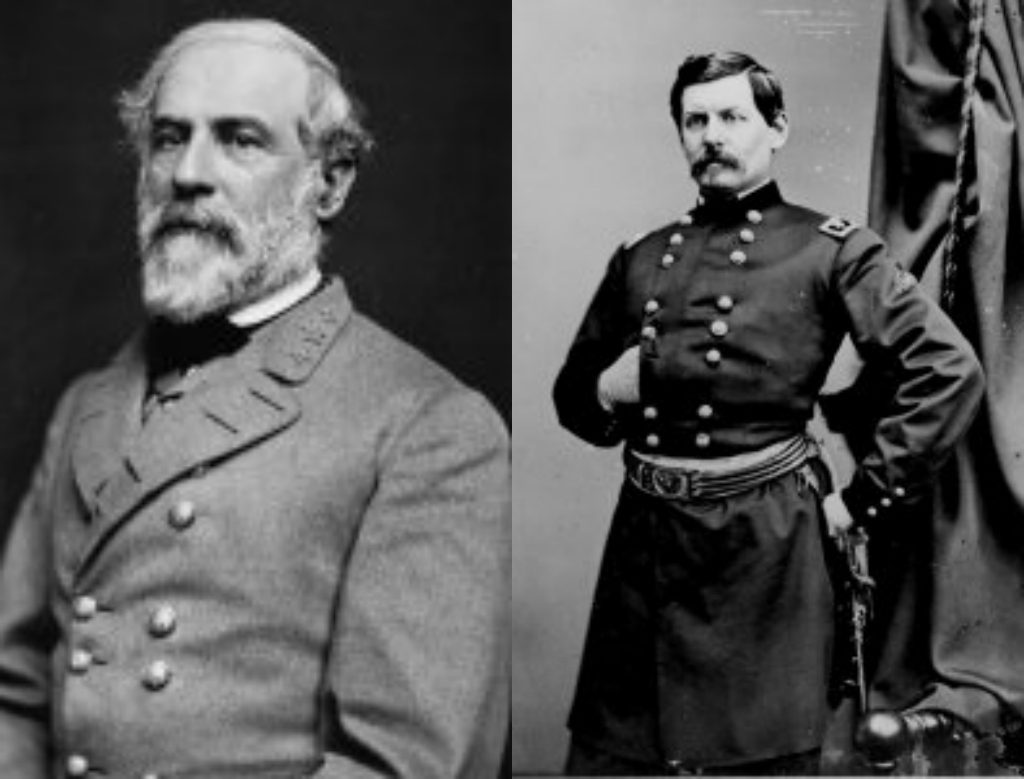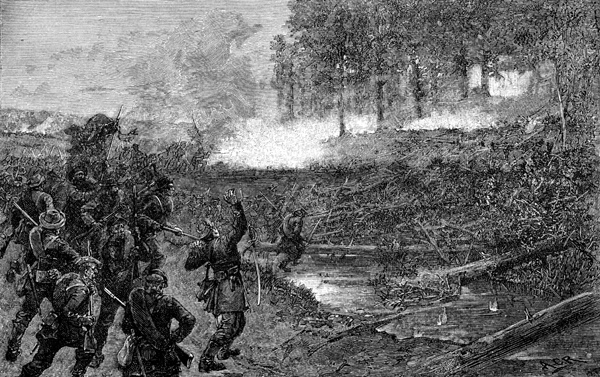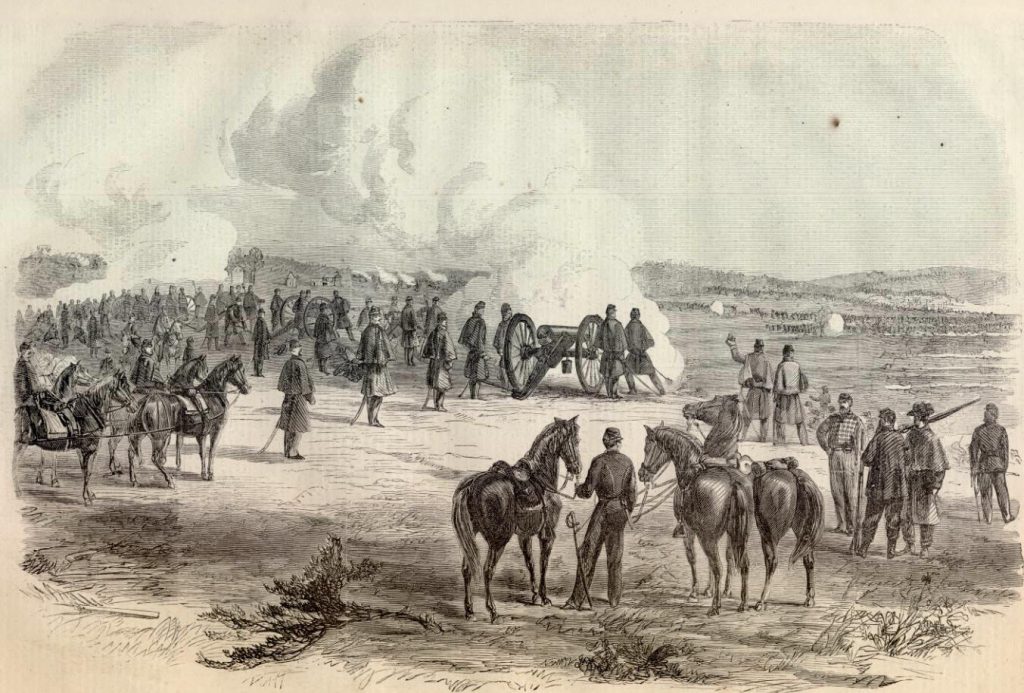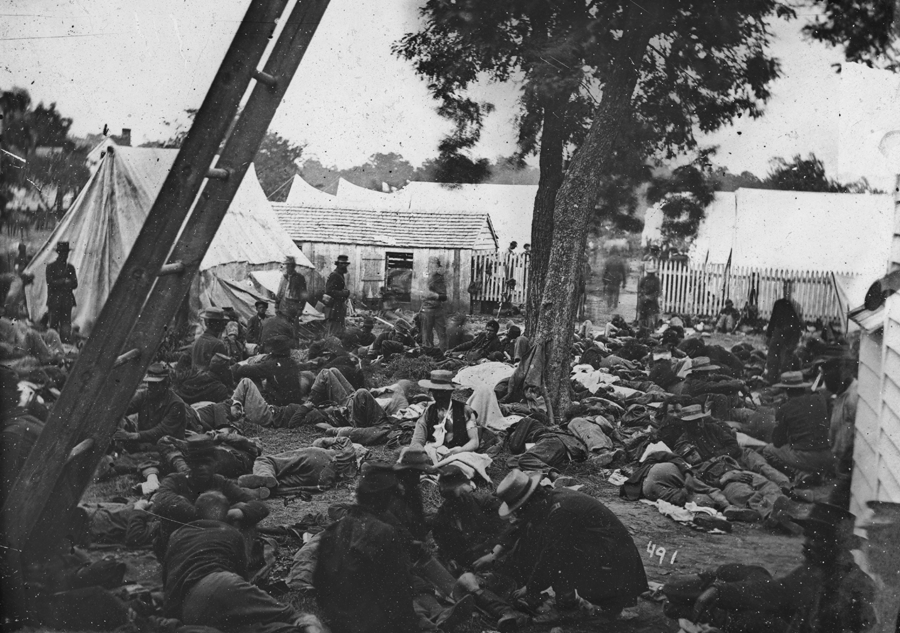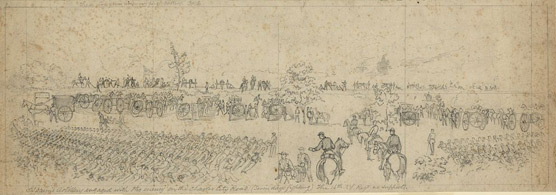Six major battles, called the Seven Days Battles, during the American Civil War were fought between June 25-July 1, 1862 and ended with Confederate victory. The battles were fought outside of Richmond, Virginia with the Confederate Army, led by Robert E. Lee, trying to drive the Union army, led by George B. McClellan, out of Richmond. The Union had many more soldiers, and less casualties, than the Confederacy.
The first of the six battles was the Battle of Oak Grove, taking place on June 25, 1862. Robert E. Lee had planned to make an advance on Union soldiers on the twenty-sixth, but George B. McClellan had launched an attack on the Richmond defenses the day before when he learned Lee was planning something. McClellan had hopes of getting Richmond within range of his siege guns. The Union had two divisions of III Corps that attacked across White Oak Swamp and were met with Major General Benjamin Huger’s Confederate division. Originally, McClellan had tried to call off the attack because he was three miles behind his men. Once he arrived at the front though, he ordered for his men to attack. They fought until dark and were unable to see anymore. In the end, the Union gained 600 yards and had 68 soldiers killed, 503 wounded. and 55 missing, so a total of 626. The confederacy had 66 killed, 362 wounded, and 13 missing, totalling at 441. This all happened over the course of only a day. By the end of the battle, McClellan had given Lee more time to plan, and Lee made sure to use it wisely and not waste any of it.
On June 26, the Battle of Beaver Dam Creek was fought in Hanover County, Virginia. This was the first major engagement of the Seven Days Battles. Lee had three of his divisions in motion or position by morning in case McClellan made any move on them. Confederate soldiers were south of the Chickahominy River, waiting for a time when they could cross at two bridges to get to the Union troops. Major General Thomas J. Jackson, more commonly known as Stonewall, was commanding the fourth division. He had brought his 18,000 men from Shenandoah Valley and then marched them past the Union camps rear. Lee was hoping that Jackson’s troops would force Union soldiers to abandon their defenses above Beaver Dam Creek. He began to fear something had gone wrong when Jackson did not arrive at the time he expected with his troops.
By afternoon, Jackson had still not shown up. So, Lee ordered his three divisions of about 40,000 men to attack. Major General A.P. Hill, a confederate, led his men across Meadow Bridges, causing Union pickets to eastwards. More confederates then began streaming through the now accessible Mechanicsville Bridge and joined the advancing troops. Union soldiers had already placed artillery near the bridge over Beaver Dam Creek and had dug gun pits. By the end of the battle, the Confederates had lost 1,484 men out of 16, 356 and the Union had lost 361 total of their 15, 631. The battle is considered to have a Union tactical victory and a Confederate strategic victory. Later that day, Jackson and his men had arrived far too late to fight, but their arrival made McClellan realize he would be unable to hold the line at the creek, and withdrew early the next morning.
The Battle of Gaines’s Mill was fought on June 27, 1862 in Hanover County, Virginia. That morning, Lee had realized that morning that Jackson’s arrival had effected McClellan and his men. Union Major General Fitz John Porter commanded his men to build breastworks of fallen trees and brushes. Engineers selected a new defensive position that was three miles east of their previous spot and was a plateau above a large ravine. Porter put artillery in the ravine, hoping that their defensive position could be held until McClellan arrived with reinforcements. Meanwhile, Lee and his troops were marching onwards towards the Union soldiers and Jackson marched to the right of union camps and seized the crossroads called Old Cold Harbor. Lee’s main goal was to get the railroad that was nearby the crossroads. The railroad would be able to threaten the Union soldier’s main escape route across the Chickahominy River. Lee and his men made their way down the river so that way Lee could meet there with Jackson once he had marched around Union camps.
Near Dr. William Gaines’s Mill, skirmishing began and spread towards the east when A.P. Hill’s Confederate men made their advance on the Union army. However, the Confederates were at a disadvantage because they did not have any maps and were unfamiliar with the area. Hill and his men reached Boatswain’s Creek not long after fighting began, which only intensified the battle and fighting. By that afternoon, his men were suffering, but Lee was feeling confident that when Jackson reached Old Cold Harbor everything would be alright. Jackson arrived much later, yet again, than expected because he needed a guide to show him how to get to the Old Cold Harbor. He ended up marching towards New Cold Harbor, and did not realize it until they had arrived. From there, he had to march towards Old Cold Harbor, causing him and his 20,000 men to arrive at the battlefield much later in the afternoon than expected. Lee ordered for Major General James Longstreet’s men to issue an assault from where they waited for instruction on the Confederate right in hopes jackson could seize the Union’s route for retreat. Porter became overwhelmed by the many Confederate assaults, and retreated with his men at nightfall. The Union lost 6,837 men in total, 894 killed, 3,107 wounded, and 2,836 either missing or captured of their 34,200+ men. The Confederates lost 7,993 men in total, 1,483 killed, 6,402 wounded, and 108 either missing or captured of their 57,000+ men. This turned out to be the first victory of the Seven Days Battles for the Confederacy.
After the battle, the Union soldiers crossed south of the Chickahominy, causing them to abandon being able to use the Richmond & York River Railroad for defenses. McClellan had also lost his supply line and would have to resume trying to take Richmond until a new line was established. Lee had began working out another plan right after the battle. Jackson was commanded to follow McClellan’s army and Longstreet and Hill were to re-cross the Chickahominy upstream, where they would cut off Union soldiers before they had the chance to reach the James River.
The next day, skirmishing at Garnett’s and Golding’s Farms in Henrico County, Virginia broke out, starting the Battle of Garnett’s and Golding’s Farm. Union and Confederate soldiers spent most of the day marching, instead of actually fighting. It lasted two days, from June 28-29 and ended inconclusively. The Union had 189 losses of their one brigade and the Confederacy had 438 of their one or two brigades.
On the twenty-ninth, Jackson was supposed to cross the Chickahominy, but his orders had been mixed up and he spent most of the day just waiting on the north bank. Union men had set up their rear guard over at Savage’s Station, which had once been a supply station and field hospital, and was also not far from where Jackson and his men were waiting. For a few hours, they destroyed small mountains comprised of supplies and rations. When Major General John B. Magruder showed up with his 14,000 Confederates, they began to fight. Magruder and his men were then supposed to go forward to join Jackson, but both Jackson and Magruder were given confusing orders. So, Magruder advanced without Jackson against 26,000 Union men that were under command of Brigadier General Edwin V. Sumner. They did not fight for long at Savage’s Station, and Sumner withdrew across White Oak Swamp when night came. The Battle of Savage’s Station was another inconclusive one. The Confederacy lost 473 of their men, but the union lost over 1,000 of their 26,000.
The following day, the Battle of Glendale was fought in Henrico County, Virginia. The Union men had reached Malvern Hill and were in view of their desired destination, the James River. Many men were still five miles behind at White Oak Swamp though. McClellan posted a rear guard force between Malvern Hill and the swamp at the Glendale crossroads. To reach the James, they would have to use two fo the three roads at Glendale, which was why it was so important. McClellan had also realized that his army may be split into two if the Confederates were able to seize the crossroads. Lee knew Glendale was an important location, and had his men ready to march towards it from three different directions. Longstreet and Hill’s 20,000 men were waiting southwest on Long Bridge Road, Major General Benjamin Huger had 9,000 men southeast on Charles City Road, and Jackson and Major General D.H. Hill’s 20,000+ men were south towards savage’s Station. After going through many delays and miscommunicated orders, Lee’s men were all located in a position to attack Union soldiers. They hoped that if all went according to plan, a portion of McClellan’s army would be destroyed.
However, the Union had placed artillery on Jackson’s path towards white Oak Swamp, and he made no effort to cross afterwards. His artillerymen fired across the swamp all day, but it did not do much to help. Huger’s column was also stopped before reaching Charles City Road due to artillery from Union men. Lee’s plan had not gone according to plan at all, and only Longstreet and Hill’s men were in position. And, while surveying the fighting, both Lee and President Jefferson Davis came under artillery fire. Following that, Longstreet and Hill were directed to attack around four p.m., and they continued to send their men forward for six hours, long after nightfall. Part of the union line fell early on in the fighting, but a reinforcement were quickly sent forward to fight the confederates. By the time firing ceased, the two sides had faced yet another inconclusive victory and the Confederates lost over 3,600 of their 45,000 men and the Union lost almost 3,800 0f their 40,000. After the battle ended, McClellan had 56,000 of his men defend Glendale as he went south to the James River with the rest of his men.
Lee was furious after the battle ended, it was yet another inconclusive victory and most of his men had not reached their positions in time. The next morning, he urged his generals forward towards the Union men on Malvern Hill. After examining the hill with Longstreet, Lee came to believe they had a possibility of breaching the Union line by artillery fire and then a strong infantry assault.
The Battle of Malvern Hill did not go as Lee planned. Yet again, orders were miscommunicated and they had bad timing, causing his plan to fail. His infantry was not strong enough against Union artillery, and the Confederate artillery was not a strong enough match against the Union. By the end of the battle, it was a tactical Union victory, and the Confederacy had suffered about 5,650 losses of their 55,000. The Union had lost 3,000 men, a large number, but less than the Confederates, of their 54,000. General D.H. Hill, who lost many of his Confederate men, even wrote afterwards that the battle was more like murder than war.
The Seven Days Battles was the bloodiest week in all of American history, with over 34,000 casualties. The Confederates lost about 19,000 men overall and the Union 15,000. Afterwards, it seemed apparent that the Confederates needed a much more superior military leader and that Robert E. Lee was not doing a great job in command of the army. Despite what most people believed, Lee was able to come back out a month later with his army stronger than ever. The battles that took place over the week of June 25-July 1, 1862 were a huge turning point in American history and the Civil War.


